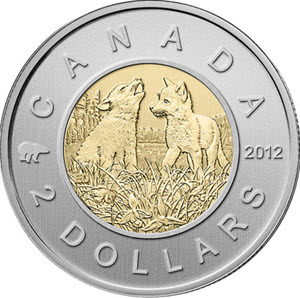Canadian dollar
The Canadian dollar is the official currency of Canada.
Over 80% of the volume of the global FX market is comprised of seven currencies, and the Canadian dollar is one of them, even though Canada is only the 10th largest economy in the world and only 9th in terms of exports.
In the table below, you can see the Canadian dollar’s position in terms of volume for FX trading in April 2013. Please note that each trade always involves a currency pair comprised of two different currencies. That is why the USD can be involved in 87% of all trades while the Euro is involved in over 33% of all trades, and the Japanese yen is involved in 23% of all trades, and so on.
| Most traded currencies by value (April 2013) | ||
| Rank | Currency | % daily share |
| 1 | United States dollar | 87.0% |
| 2 | Euro | 33.4% |
| 3 | Japanese yen | 23.0% |
| 4 | Pound sterling | 11.8% |
| 5 | Australian dollar | 8.6% |
| 6 | Swiss franc | 5.2% |
| 7 | Canadian dollar | 4.6% |
| 8 | Mexican peso | 2.5% |
| 9 | Chinese yuan | 2.2% |
| 10 | New Zealand dollar | 2.0% |
The Canadian dollar is the 5th or 6th most held reserve currency in the world (it varies from year to year). At the time of writing, roughly 2% of the total amount of money held in national currency reserves are Canadian dollars.
 Basic information about the Canadian Dollar
Basic information about the Canadian Dollar
- The ISO 4217 code for the Canadian Dollar is CAD (numerical: 124).
- The symbol for the Canadian Dollar is $ or C$.
- The central bank for the Canadian dollar is the Bank of Canada.
- 1 Canadian Dollar equals 100 cents. The symbol for the cent is ¢.
- The Canadian Dollar is sold freely on the FX market.
- The Canadian Dollar used to have a gold standard but doesn’t anymore.
Monetary policy
The Bank of Canada has no specified target value for the Canadian dollar against any other currency.
Usage outside Canada
Although Euro is the official currency of Saint Pierre and Miquelon, the Canadian dollar is widely accepted. The Overseas collectivity of Saint Pierre and Miquelon is a self-governing territorial overseas collectivity of France. It is located in the northwestern Atlantic Ocean, near Newfoundland, Canada. The French name for this overseas collectivity is Collectivité d’Outre-mer de Saint-Pierre-et-Miquelon.
Trivia
- The Canadian dollar is called Dollar canadien in French. The cent is colloquially referred to as sou in French. (Both English and French are official languages of Canada.)
- Examples of nicknames for the Canadian dollar are Loonie, Buck, Huard and Piastre.In the 1600s, the Hudson’s Bay Company minted a coin with a value equal to the pelt of one male beaver. A male beaver is a buck.
In 1987, the Canadian 1 dollar bill was replaced with a 1 dollar coin. The back of this coin was adorned with the sea-bird Common loon, hence the nickname loonie.
- In 2012, Iceland considered adopting the Canadian dollar as an alternative to the Icelandic króna.
This article was last updated on: October 1, 2022